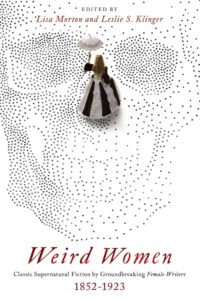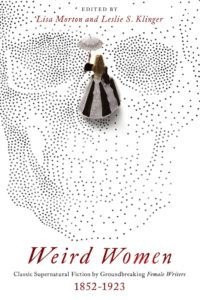“. . . if our authoress can forget the gentleness of her sex, it is no reason why we should; and we shall therefore dismiss the novel without further comment.”
—from The British Critic’s 1818 review of Mary Wollstonecraft Shelley’s Frankenstein
Any student of the literary history of the weird or horror story can hardly be faulted for expecting to find a genre bereft of female writers, at least in its first two centuries. A few of the authors included in this volume—Charlotte Perkins Gilman, Mary Wilkins Freeman, Clemence Housman—were discussed in early studies like H.P. Lovecraft’s Supernatural Horror in Literature (1927); some would be acclaimed in later, more exhaustive works like The Penguin Encyclopedia of Horror and the Supernatural (1986); and others would find later fame thanks largely to filmed adaptations of their work (Herminie Templeton Kavanagh with Disney’s 1959 Darby O’Gill and the Little People, and Edith Nesbit with the BBC adaptation of The Railway Children in 1968). But reprint anthologies of horror published throughout the twentieth century could routinely be counted on to include few or no stories by women. Perhaps the editors of those books were concerned about “the gentleness of her sex.”
Yet there were women writing early terror tales—in fact, there were a lot of them. During the second half of the nineteenth century, when printing technologies enabled the mass production of cheap newspapers and magazines that needed a steady supply of material, many of the writers supplying that work were women. The middle classes were demanding reading material, and the plethora of magazines, newspapers, and cheap books meant a robust marketplace for authors. Women had limited career opportunities, and writing was probably more appealing than some of the other avenues open to them. Though the publishing world was male-dominated, writing anonymously or using masculine-sounding names (such as “M.E. Braddon”) gave women a chance to break into the market. It was also still a time when writers were freer than today’s writers to write work in a variety of both styles and what we now call genres. A prolific writer might pen adventure stories, romantic tales, domestic stories, mystery or detective fiction, stories of the supernatural—there were really no limits.
Spiritualism—the belief that spirit communication could be conducted by a medium at a séance, and could be scientifically proven (despite continued evidence to the contrary)—was widely popular, and so one might expect to find that many writers of this period were producing ghost stories. But ghost stories were just one type of supernatural story produced by women writers at this time. Women were also writing stories of mummies, werewolves, mad scientists, ancient curses, and banshees. They were writing tales of cosmic horror half a century before Lovecraft ever put pen to paper, and crafting weird westerns, dark metaphorical fables, and those delicious, dread-inducing gems that are simply unclassifiable.
This range of subjects is, of course, not unique to women writers, but there are nonetheless certain attributes to much of their work that are distinctly feminine. Not surprisingly, many stories from the nineteenth and early twentieth century feature women involved in traditional feminine pursuits—family, children, and even gardening all figure prominently in their fiction. Look, for example, at the terror and pathos surrounding the children at the heart of Charlotte Perkins Gilman’s “The Giant Wistaria,” Mary Wilkins Freeman’s “The Wind in the Rose-bush,” Elizabeth Stuart Phelps’s “What Was the Matter?,” and Olivia Howard Dunbar’s “The Dream-baby.” In the latter story, the author addresses head-on the self-worth of childless women, even when their lives are otherwise satisfying.
These early female authors often introduced social commentary into their works, especially issues of the role of women and class struggles. The suffragette movement and labor reform were important throughout this period of time; in fact, the vast majority of the women included in this book were involved in these movements, as well as socialism (and, of course, spiritualism). During the nineteenth century, work as a domestic was one of the few options available to women who were either not born into the middle or upper classes, or were unfortunate enough to fall from them, and several of these stories—Elizabeth Gaskell’s “The Old Nurse’s Story,” Dora Sigerson Shorter’s “Transmigration,” Frances Hodgson Burnett’s “In the Closed Room”—are told from the point of view of either domestics in a wealthy household or the very poor. A story like Marjorie Bowen’s “Twilight” took the reverse tactic of turning one of history’s most decadent, wealthy figures (Lucrezia Borgia) into a nightmarish vision that terrifies a young man, while Ellen Glasgow’s “Jordan’s End” traces the macabre fall of a once-great family. Olive Schreiner’s “In a Far-off World” and Regina Miriam Bloch’s “The Swine-Gods” use rich, dark metaphors—complete with bloody sacrifices—to illustrate societal ills like war, greed, and disparity between the genders in relationships. And then there are the ghost stories, which speak to how these authors both romanticized and feared the past.
While it seems downright shocking today to think that anyone could decide to support a family by writing and actually do it in a relatively short period of time, a number of the writers included here—women who abruptly found themselves without a father or a husband and with siblings, children, or elderly parents to support—entered the writing field for precisely that reason. Ann Radcliffe, one of the greatest female novelists in the years prior to Jane Austen and the Brontë sisters, was the highest-paid writer of the 1790s, and a century later Marie Corelli (whose lovely and eerie “The Lady with the Carnations” is a fine example of her work) would hold that honor in the 1890s. But even a writer of moderately successful short stories could keep a family on her earnings during this time, and without resorting to a life of drudgery in a factory or wealthy household. Writing also gave women the chance to receive the same pay as men, especially if they were satisfied with anonymity. Two of the most famous authors of the period who originally took up writing out of financial need (and both of whom appear in this book) were feminist icon Charlotte Perkins Gilman—who, by the way, was also an early user of self-publishing—and Frances Hodgson Burnett, who, like Louisa May Alcott, became known for her children’s books although both enjoyed writing supernatural tales (Alcott, in fact, actually preferred writing them). Charlotte Riddell—another author who took up the pen to support herself and her mother—produced ghost stories that felt drenched in the folklore of the past, with their plots often depending on the time-honored tradition of a haunting that originated from a murder (see “Nut Bush Farm”). Sarah Orne Jewett’s “The Gray Man,” written about fifty years after Nathaniel Hawthorne’s “The Gray Champion,” almost reads as a feminine answer to that earlier story; whereas Hawthorne’s ghost returns to engage in battle, Jewett’s specter is a participant in gentler activities like teaching and gardening (however, Jewett also captures the hint of irony underscoring Hawthorne’s tale).
While many of these women certainly wrote as much from the simple, basic writer’s need to tell a story, there’s another key difference between them and their male counterparts: call it ego or ambition . . . or lack thereof, because many of these women wrote under pseudonyms, used their married name (Riddell and Gaskell were usually known as Mrs. J. H. Riddell and Mrs. Gaskell), or in some situations—like Harriet Spofford’s astonishing weird tale “The Moonstone Mass”—under no byline whatsoever. Many of these authors were friendly with male writers who would go on to achieve greater fame, or they were tremendously admired by famous men, only to see their own names fade into semi-obscurity. Emma Frances Dawson, whose collection An Itinerant House and Other Stories is now a sought-after rarity in the secondhand market, was a great favorite of Ambrose Bierce, who frequently served as her editor, yet there’s conjecture that Dawson died (at the age of 87) of starvation. Similarly, the mysterious Regina Miriam Bloch, once rumored to be the great Rebecca West, and who had been acclaimed by the British newspapers when her two short story collections, The Swine-Gods and Other Visions and The Book of Strange Loves, were released in 1917 and 1918 respectively, didn’t merit a single mention in any paper upon her death in 1939.
Fortunately, the rise of the academic genre and feminist studies over the last few years has (deservedly) brought some of these authors back into the limelight; and fine small presses like Ash-Tree Press have provided introduction xiii lovely new editions of their works. We hope this volume will serve to continue introducing more of these gifted—and very dark—works to modern readers.
Excerpted from the Introduction to Weird Women: Classic Supernatural Fiction by Groundbreaking Female Writers: 1852-1923, by Lisa Morton and Leslie S. Klinger. Published by Pegasus Books. Reprinted with permission of the publisher. Copyright © 2020. All rights reserved.



















